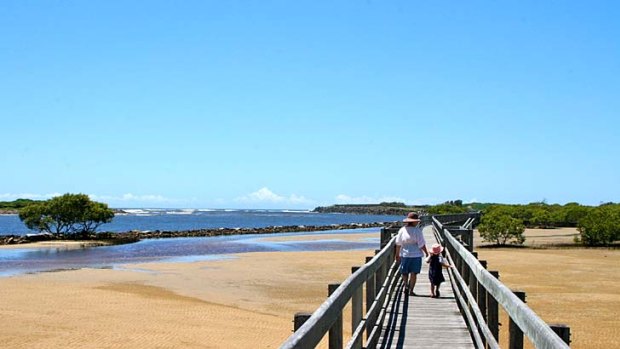This was published 9 years ago
Urunga, New South Wales: Travel guide and things to do

Coasting ... Urunga boardwalk stretches from the river to the beach and the mangroves.Credit: Daniel Scott
Located 530 km north of Sydney at the mouth of the Bellinger and Kalang Rivers, Urunga is one of those secret places where people come to retire and where, because it is bypassed by the Pacific Highway, there is a charming olde world, untouched feeling. It is far removed from the commercialism which has characterised so much of the New South Wales North Coast.
Urunga (the town is reputedly an Aboriginal word meaning 'long white sands') has a population of 2000 of whom probably as many as 65 per cent are people who have moved to the area to retire. The attractions are obvious. The town is not well known. It is a pleasant, sleepy little place located between the Bellinger and Kalang rivers with some beautiful walks around the foreshores, plenty of fishing and sporting activities like golf and bowls and lots of sun and salt air. It is so easy to spend a couple of hours gazing out over the river from the lounge of the Golf and Sports Club, and there is no sense of urgency or overwhelming feeling of tourism. As one retiree said: 'It's a secret. Don't tell too many people about it.'
One of Urunga's advantages is that it is by passed by the Pacific Highway. To get to the town the visitor has to leave the Pacific Highway, cross the railway line, and wind down into a town which doesn't seem to have an obvious centre.
There's lots of evidence that in the 1950s it was a fibro town of holiday homes and fishermen's houses. Slowly those fibro dwellings have been turned into brick veneer project homes so that the town has a new, clean, rather wellheeled feel about it.
In spite of its consciously low profile, Urunga is the largest town in the Bellingen Shire.
Before European settlement the Urunga area was inhabited by the Kumbangerie (sometimes written 'Gumbaynggir) Aborigines who moved around an area which was bounded by Woolgoolga in the north, Dorrigo to the west and Nambucca Heads to the south. There is considerable evidence of massacres and maltreatment of the local Aborigines during the 19th century. The last known full blood, named Black Jimmy by the settlers, died at Bellingen in 1922.
In 1841 William Miles, a stockman from Kempsey, was the first European to enter the Bellinger Valley. He recognised the rich potential of the cedar which abounded in the area. The following year the Northumberland crossed the bar at the site of modern day Urunga. It heralded a 'tree rush' with cedar cutters moving into the area, cutting the trees and waiting for the floods to move the trunks down to the river mouth. The cutters were followed by farmers who, recognising the rich potential of the river valley's alluvial soils, grew maize and grazed dairy cattle.
By 1868 a pilot station had been built at Urunga (then known as Bellinger Heads) to help the sailing ships across the bar and up the river. The mouth to the river was always dangerous and inevitably it saw a number of dramatic shipwrecks including the Violet Doepel. By 1892 a breakwater had been constructed to help shipping but this was in vain as the improvement of rail and road meant that by 1933 the Pilot Station had been closed down.
Things to see
Bellinger Valley Historical Museum
On the river to the east of the town and opposite the Caravan Park in Morgo Street is the Bellinger Valley Historical Museum which is open from 2.00 p.m. 4.00 p.m. on Wednesday. However the town's Bicentennial exhibition tracing the local history from Aboriginal settlement some thousands of years ago is in the Urunga Library in Bonville Street and is open for inspection during Library hours.
The Museum is still worth visiting (even if you don't arrive on a Wednesday afternoon) because outside is the headstone of James Thrower (it is rare in that it is a headstone without either a grave or a body) and the Museum itself is located in the old Literary Institute, a charming wooden building which was constructed in 1896.
The inscription on Thrower's gravestone reads: 'Sacred to the memory of Mr. James Thrower late master of the cutter Comet of Sydney who suddenly departed this life in a boat while engaged in sounding the bar of the Bellinger River. His vessel laying at anchor June 4th 1846.'
The Pilots Cottage
On the hill above the boardwalk, at 4 Morgo Street, and looking out to the heads at Urunga is the old Pilot's Cottage (it is not open for inspection having been converted into Pilot House Bed & Breakfast). It boasts one of the most pleasant views available and some unusual statues of pelicans above the front gate. The front view can be accessed by a narrow lane which is further up Morgo Street. This lane leads out to a small park which offers fine views over Urunga Heads.
Ocean View Hotel
Just along the road is the Ocean View Hotel. Established in 1927 it is a typical grand seaside pub which has recently been restored and refurbished. The view from the hotel is outstanding.
Water Rat Cruises
Water Rat Cruises offer a range of different cruises on the Kalang and Bellinger River. Contact (02) 6655 6439 for details.
The Honey Place
Located on the Pacific Highway just south of the Urunga turnoff, the Honey Place is an ideal location to see the entire honey making process and purchase a wide range of delicious honeys.
Tourist Information
Urunga Tourist Information Centre
Pacific Hwy
Urunga NSW 2455
Telephone: (02) 6655 5711
Facsimile: (02) 6655 5711
Sign up for the Traveller Deals newsletter
Get exclusive travel deals delivered straight to your inbox. Sign up now.